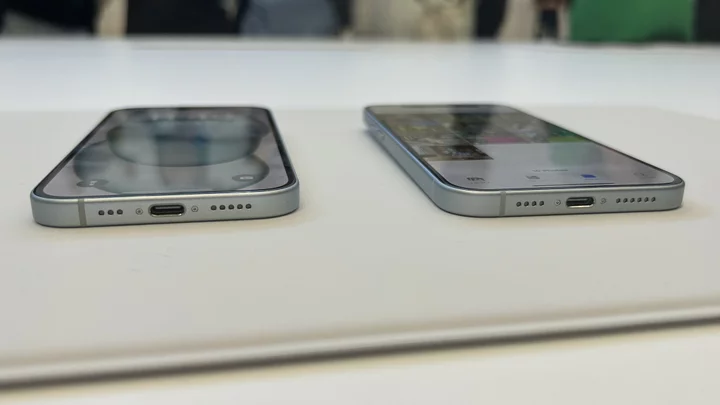Apple's Lightning Connector is dead—on its newest iPhones, at least. Thanks to European Union regulators, all phones, tablets, and cameras will be required to use the USB-C charging standard by 2024, forcing Apple into USB-C port adoption.
Greg Joswiak, Apple's SVP of Marketing, begrudgingly admitted last year that "we have no choice" but to move away from a proprietary charger to take up the more universal USB-C plug. And that was the case this month when Apple unveiled the iPhone 15 lineup with USB-C.
Why USB-C?
(Credit: Jaromond /Shutterstock)In the EU, USB Type-C will become the new standard for portable devices, for both charging and data transfers, in order to reduce e-waste, provide faster charging speeds, and give users the choice of purchasing a new device with or without a charger.
Regulators also want to eliminate the “lock-in effect” that keeps users dependent on a single company. For example, iPhone owners are currently dependent on Apple to provide them with Lightning Connector charging unless they upgrade to the iPhone 15.
By mandating USB-C, customers have more choice when it comes to the power accessories they buy for their devices. You could buy a fast charger or a power bank from any company and it would be compatible with your device. The USB-C chargers already out there would also work without the need of an adapter.
Why Didn't Apple Switch to USB-C Earlier?
What's in the box with an iPhone 15 (Credit: Apple)Android devices, and even Apple's own iPad have long embraced USB-C. Why the delay on iPhone? While Apple has never directly stated that profit is a main driver for fighting USB-C standardization, Apple created its own MFi (Made for iPhone) certification program, which regulates the quality of third-party manufacturer’s cables and accessories, and gives a commission of sales to Apple. USB-C adoption could turn off a valuable revenue stream, though Apple is not limiting data and charging speeds to MFI-certified accessories on the iPhone 15.
Apple has also stated that sticking with the Lightning port in the iPhone has more to do with the amount of waste that potentially would be created as a result of millions of iPhone users being forced to discard those cables. The company has already ditched the pack-in power adapter and EarPods with new phones, starting with the iPhone 12, in the name of environmentalism.
These days, all that's included in a new iPhone box is a Lightning-to-USB-C cable on older models or a USB-C Charge Cable on iPhone 15 models, which means customers must either use their old adapters or purchase new chargers from Apple. The company argues that many people already own power adapters and don't need another one creating clutter, but removing that power adapter, yet still charging the same price for the phone, may strike some as more of a money grab than a sustainability move.
How to Prepare for a USB-C iPhone
USB-C port on the iPhone 15 (Credit: Angela Moscaritolo)A USB-C iPhone is just days away; the iPhone 15 officially launches on Sept. 22 (though pre-orders are open now). However, since many Android phones, headphones, portable speakers, and other devices support the standard, you may already have everything you need at home.
If you own certain iPad or MacBook models, the USB-C charger that came with your device will also work with your iPhone. These are the models that have USB-C charging:
iPad Pro 11-inch (1st generation or later)
iPad Pro 12.9-inch (3rd generation or later)
iPad Air (4th generation or later)
iPad mini (6th generation)
MacBook Pro introduced in 2016 or later
MacBook Air introduced in 2018 or later
MacBook introduced in 2015 or later
Since the USB-C iPhone includes a USB-C cable, you can plug your phone into a USB-C Mac in order to charge. If you do not have any USB-C devices in your house (or no extra cables lying around), you will need to purchase a USB-C power adapter and/or cable to charge your iPhone through a wall outlet. Apple already sells a number of USB-C power adapters and cables:
What About MagSafe and Wireless Charging?
If you don't want to mess around with wire compatibility, many people have opted to charge their smartphones wirelessly. This allows you to lay your phone down on a wireless charging surface to initiate device charging. Since the iPhone 12, MagSafe wireless chargers can magnetically connect to the back of your iPhone.
Wireless charging makes figuring out which cables connect to what adapters even less of a concern, but there are still reasons to have a functioning USB-C cable and adapter around.
While there are some wireless fast chargers on the market, a wired connection is typically faster across the board. You can also take advantage of Apple's higher wattage power adapters that are specifically designed to charge your device at a faster rate.
Additionally, wireless charging accessories can’t transfer data from one device to another, so you would still want a cable to create an encrypted backup of your iPhone to your computer. Also, if you have an older home theater receiver or car stereo, you will have to physically connect the two by a cable.
Chloe Albanesius contributed to this story.

